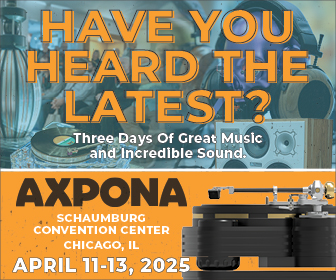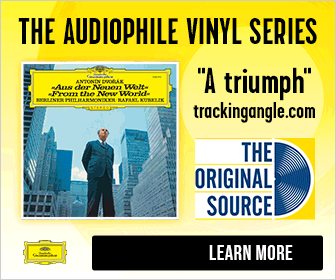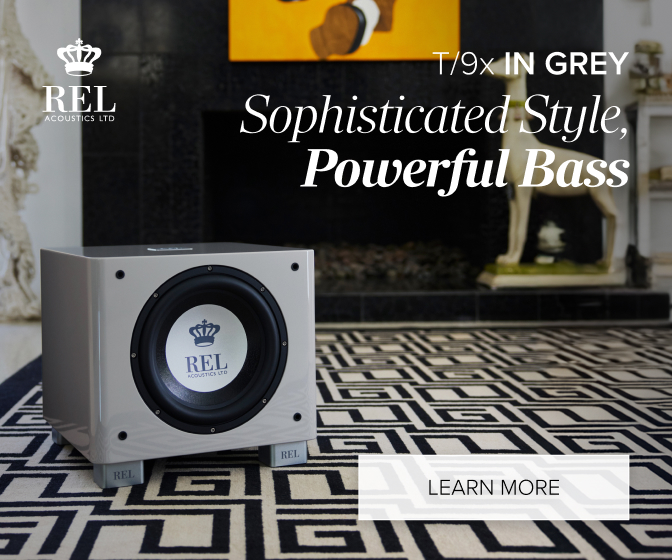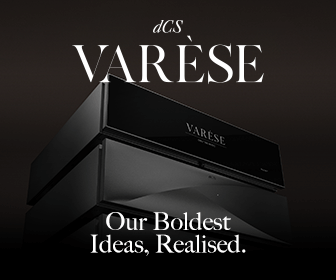Oracle Audio Delphi Mk VII Turntable— A Piece Of Art Or A Record Player?
the latest update to the Legend of Delphi, the MK VII offers reference-quality sonics.
Yes. The Oracle Audio Delphi Reference Mk VII turntable is both a work of art and a record player. With an MSRP of $14,000, I wouldn’t think it strange for a non-audiophile who is an art and music lover to purchase an Oracle simply for its beauty and to play records.
The Delphi Mk VII, however, is much more than a pretty face. As gorgeous as the Delphi (of any version) looks, its primary raison d’etre is to extract information. It's a precision instrument helping to assist a tonearm and phono cartridge to accurately trace the microscopic physical information contained in the PVC groove of a record. And it does this superbly well.
Like most audiophiles of a certain age, I was already quite familiar with Oracle. Most of us have stories. I remember the nuclear explosion when the Oracle Delphi AC first hit the scene. When Linn was the king of the turntable hill, a Sondek was virtually invincible. No other turntables could remove that crown. That is until the Oracle Delphi came along and broke the spell. After that, for a very long time things were never the same.
About 30 years ago, I had a roommate named Jeff. We split the rent on a cool old house in central Austin. He had a bangin’ hifi that included a Delphi—I have no idea what iteration. I loved that turntable and spent lots of quality time listening to Jeff’s system and his vast (40,000+) record collection. My unrequited love affair with an Oracle Delphi began there. But even then, Oracle had been on the scene going strong for 10 years.
I recently attended the Montreal Audio Fest, where TrackingAngle's own Michael Fremer presented original Delphi designer Marcel Riendeau a Lifetime Achievement Award for over 40 years of excellence in the HiFi industry. This is an insanely long time for a product to be in production, albeit with incremental improvements.
Oracle has to date produced over 10,000 turntables. In the early days, Canadian Prime Minister Pierre Trudeau gave Oracle Delphi turntables as gifts to many heads of state to show off the quality and excellence of Canadian engineering. I won’t go too deep into the history of this great HiFi company, but I encourage interested readers to look online for the backstory. One part of the story I will talk about is how things almost ended for Oracle during the nadir of vinyl in the mid-90s and early oughts.
Although Marcel left Oracle Audio to do other things, during The Dark Age Of CD, Jacques and his business partner Stephane Nadeau kept the vinyl playback flame burning. During this time, the Delphi V appeared—technically the 6th improvement to the original Delphi AC introduced in 1979.
In fact, over 44 odd years, Jacques and his team of dedicated craftsmen (two of whom have been with Oracle for over 30 years) have continually improved Marcel’s original design. A detailed timeline and what the improvements are for the various iterations of the Delphi are on the Oracle Audio website.
I think it’s interesting that while using creative thinking and the latest tech to improve sonics in the Delphi series, these changes have not diminished the original design's physical beauty and aesthetic essence. In my opinion, the Delphi Reference Mk VII is the most beautiful thus far.
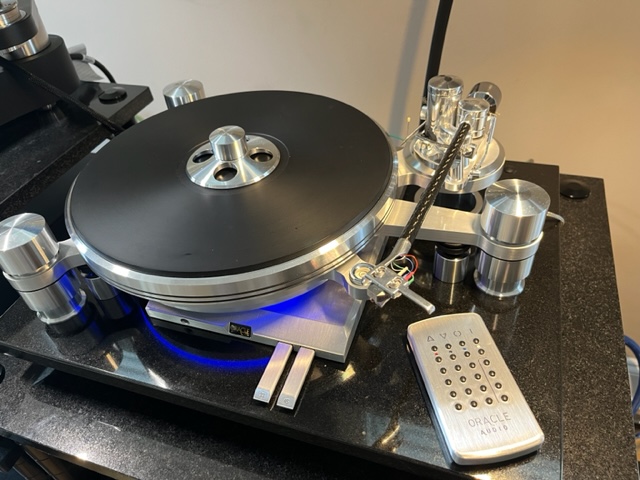 Travels With A Delphi
Travels With A Delphi
Scene: the Acora Acoustics room at the 2023 Tampa International Audio Show. “I can’t get over how amazing this thing sounds. I’d love the opportunity to review it,” I said. “Why don’t you take it home after the show? But I need it back in time for AXPONA,” says Jacques Riendeau. “It’s brand new; the Mk VII is our latest model; you would be the first to review it.”
BING, BING, BING. There was an immediate light show and the sound of a pinball machine. OMG, an Oracle turntable. I’m counting how many days I’d have and trying to figure out if it’s possible to make the time. “Sure, I’m game!” It’s the new Oracle Delphi Mk VII, for chrissakes. So I’ll make the timeline work.
There is a prior element to this story: I first met Jacques at the 2022 Toronto Audiofest. At an informal after-hours thing, I played some records I had brought and talked about why each one sounded the way it did—from the perspective of a guy in pro audio production who cuts lacquers for vinyl production. I didn’t know who the dude with the shaved head and glasses in the audience was, but he asked the most questions, and all of them were great. Later, I was flattered to find out that he would be Jacques Riendeau of Oracle Audio. So the following day, I watched and learned as he did a knowledgeable cartridge setup, primarily by dialing in the azimuth. The sonic improvement was obvious.
Fast forward to hitching a ride home from the Tampa show with a fellow audiophile friend and his wife. A friend with a big truck and room for me and a couple of boxes with Oracle Audio printed on them. Praise The Lord.
Intermission
For readers unfamiliar with Oracle's design philosophy, I'll try and explain without putting you to sleep. The Delphi is in the class of suspended chassis turntables, made famous by the Linn Sondek. The theory is that the delicate platter/tonearm ecosystem is isolated from any vibration, which obscures accurate retrieval of the micro-sized info in a record groove. Unlike a Linn, which hides suspension springs, sub-chassis, and whatnot in a conventional-looking package, Oracle displays all the workings. The Oracle design team listened extensively to arrive at improvements, particularly since the introduction in 2010 of the Delphi Mk VI.
The inner and outer platters are machined from a solid billet of 6061T6 aluminum magnesium alloy, diamond cut finished, and then high-quality lacquer coated. This has been the case since the very first Delphi. The distribution of platter mass mostly around its outer edge creates a flywheel effect. Oracle pioneered the now well-established “record clamping system” to solve specific vinyl disc “warp” problems.
The trio of spring suspension assemblies has been extensively refined through the years. It uses 12 different components, including 7, for mechanical filtering. One of the most sonically important improvements is what Oracle calls its Micro Vibration Stabilizer System (MVSS). Three adjustable Delrin cone-shaped plungers protrude from the bottom of the sub-chassis into round trays of 100 cTs silicone fluid reservoirs.
Jacques told me he likes to think of the MVSS as a mass simulator that can create a camera-like focus. But be careful with those adjustments, or you could shift yourself into a parallel dimension.
Specific changes for the Delphi Mk VII are as follows:
The main bearing has a glass-filled non-metallic Torlan thrust plate to support a Carbide-tipped spindle. The two-bushing system has been replaced by a new dual tripod system using six precision surfaced PEEK screws. This allows a very high precision calibration of the spindle holder assembly. These changes are critical to keeping bearing chatter and micro-movement to a minimum.
A specially selected AC synchronous motor with very accurately balanced coil internal impedance. The Delphi MkVII drive circuit is a precision frequency generator allowing a very accurate calibration of 33 and 45 speeds. The drive circuit also allows for the positive and negative sinewave calibration to balance the voltage in each coil, creating a very smooth and balanced vibration-free spinning motor. This circuit section now has military-grade capacitors to ensure the smoothest possible sine wave.
Oracle's Turbo Power Supply is now a Mk2 version with precision DC voltage output calibration at 24.35 VDC (arrived at by ear), allowing the motor drive system to precisely feed the AC synchronous motor. This is key for optimal motor rotational stability and to further reduce the vibration generated by the motor poles.
The 8.8-pound platter is now separated into main and sub-platter pieces. This makes much easier fitting the belt and the spindle into the bearing.
The turntable's base is now 38 pounds of Black Granite.
But What About The Tonearm?
During its 43-year history, Oracle has preferred to sell its turntables with OPT—Other People’s Tonearms. In past years it was common to see an SME arm mounted on an Oracle ‘table. More recently, the most excellent Reed tonearms have been commonly fitted. SME no longer sells its arms separately, which may have factored into Oracle's decision to finally make a tonearm. I was able to test a prototype of this soon-to-be-available beauty. More on that later.
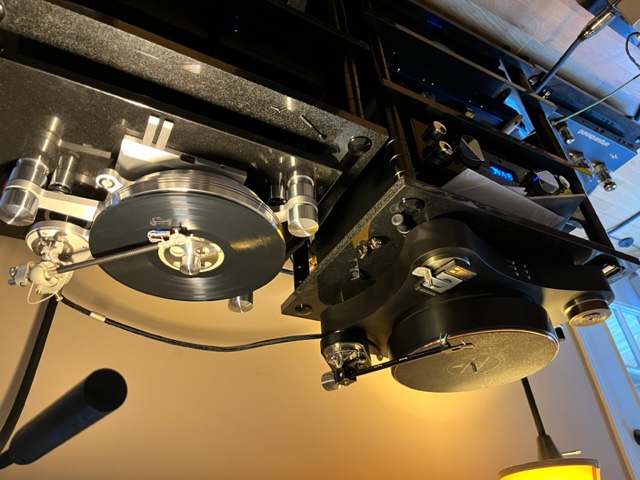 I fitted the Delphi Mk VII with a Reed 1H tonearm. The 1H at around $4K is the entry-level in the Reed line, which goes up to a 5T at a cool $24,000. Who hasn’t admired these beautiful creatures mounted on some of the world’s finest (and priciest) turntables? I know I have.
I fitted the Delphi Mk VII with a Reed 1H tonearm. The 1H at around $4K is the entry-level in the Reed line, which goes up to a 5T at a cool $24,000. Who hasn’t admired these beautiful creatures mounted on some of the world’s finest (and priciest) turntables? I know I have.
At the Tampa show, in the Acora Acoustics room, I heard the Delphi VII with a Reed 1H, which sounded stupendous. That was fitted with a Lyra Atlas cartridge. I was sure my Dynavector XV-1t was up to the task. I wasn’t sure how little ole me would reassemble the Delphi and the Reed, but I’ve successfully set up a lot of high-end rigs before. I can figure out an Oracle and a Reed. They have a thing now called FaceTime. And Jacques can help me. And, and, and. But what about the whispers I heard from some knowledgeable folks at the show? “Yeah, that rig sounds great, but setting up is a royal pain.” I will banish those thoughts - I can do this.
 Note to readers: a typical customer will ostensibly purchase a high-end turntable through a dealer, not only for guidance towards the right product for the situation but also to receive setup expertise and service required from a dealer selling complex things like turntables, arms, and cartridges. Reviewers are sometimes on our own.
Note to readers: a typical customer will ostensibly purchase a high-end turntable through a dealer, not only for guidance towards the right product for the situation but also to receive setup expertise and service required from a dealer selling complex things like turntables, arms, and cartridges. Reviewers are sometimes on our own.
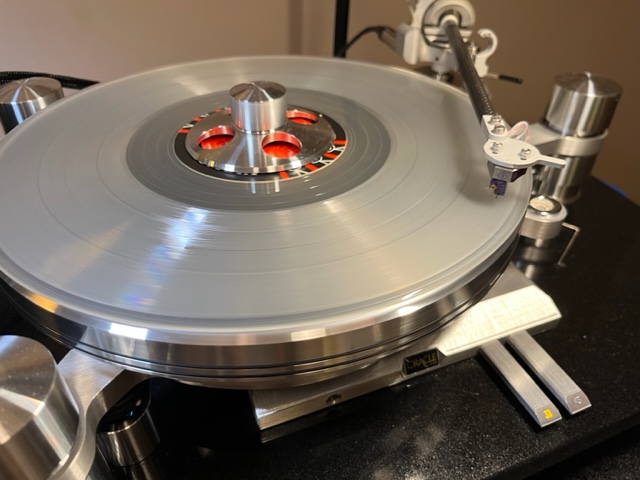 The universe decided to let me bring home from Tampa a vicious cold/flu. No, it wasn’t Covid. I’ve had that. This was worse. Then my daily mastering schedule decided to explode. And the Treehaus Audio speakers I’d promised to review arrived right after I got home. So yeah, this Oracle review will be a walk in the park. What was I thinking? I’m happy to report everything worked out just FINE. Really.
The universe decided to let me bring home from Tampa a vicious cold/flu. No, it wasn’t Covid. I’ve had that. This was worse. Then my daily mastering schedule decided to explode. And the Treehaus Audio speakers I’d promised to review arrived right after I got home. So yeah, this Oracle review will be a walk in the park. What was I thinking? I’m happy to report everything worked out just FINE. Really.
But I will say this may be the single most intense review I’ve done. It took a lot of time and a lot of work to get all the stars aligned to the point where my system, and, most importantly, the Delphi Mk VII, was correctly dialed in.
I unboxed and assembled the Delphi and Reed almost immediately after arriving home. No, it wasn’t the nightmare I half expected. Many thanks to Jacques and FaceTime for guiding me through the process. However, I quickly realized that my Dynavector XV-1t had slowly developed a problem in the suspension. The cantilever was noticeably skewed, and I could not get it to align correctly. So I borrowed a Benz Ruby Z from my trusty Ember Audio + Design homies. Chris Livengood and the crew there always come to my rescue. Thanks again, guys.
The Benz, while excellent sounding, left me feeling like I needed something a little higher resolution to work with. Ms. Delphi deserved it. The replacement Dynavector wouldn't arrive in time for me to have enough listening time (much less break-in} to complete my notes and get the boxes to Chicago in time for AXPONA.
Thanks to the massive mensch-ness of Isaac Markowitz, who sent me his personal Lyra Atlas, I now had a broken-in, top-shelf cart to complete the review. My suspicions were correct. With a super high rez cart, I had the feedback to tweak the Delphi and Reed to the nth degree and was rewarded with some of the most sublime sounds yet heard in my sonic pleasure palace.
Listening
I started by fitting the Lyra Atlas to my TW Acustic Raven LS turntable with a Raven 10.5 arm to have a baseline to hear better what the Delphi offered in sonics.
Before this, I spent a fair amount of time listening to the Delphi/Reed/Benz combo, which was quite enjoyable. However, it was no real match for my TW setup (before my Dyna started acting weird). Also, the Reed 1H was maddening to tweak VTA, azimuth, and even VTF. Yes, it’s a good-sounding arm, but be prepared to spend some time getting your cartridge of choice to sound its best. As you move up the Reed line, you should get better performance, but you also get as part of the package designs with easier adjustability.
Back to the Lyra Atlas on my TW. I’ve had some winners on the TW, but this was exceptional. Record after record, Goat Rodeo, Radiohead, Punch Brothers, Beck, Miles Davis, Kevin Gilbert, Little Feat, Blood, Sweat, & Tears, XTC, Blue Note classics, D’Angelo, large scale classical, you name it—vinyl Nirvana was achieved. And wait for it; this was only the beginning.
Swapping the Atlas to the Delphi VII/Reed 1H rig, I heard the same overall quality, with less midrange density and a looser low end. The low end was sufficiently large and extended but less controlled than the TW rig. The top end was not quite as liquid, yet very detailed. Maybe too detailed. A little jumpy, perhaps? Image specificity was good, but with less depth and 3D-ness than the TW Acustic. I’m talking about subtle yet noticeable degrees of difference. The sound improved with more cartridge alignment fine-tuning - up to a point.
It was time to get my tweak on with the Delphi, so I went right to the MVSS adjustments.I started with what Jacques feels is the default setting, then lowered the cones that attach to the solid aluminum, spring-suspended chassis by another half turn deeper into the silicone reservoirs.
The result was like magic. Now the midrange filled in, the bass got a little tighter, and the top end retained its detail but with a smoother vibe to the sound. From what I understand, the MVSS allows a fine degree of control of the sub- chassis's incredibly minute lateral and vertical movement. You get that kind of thing with an out-of-round record or your subs shaking the hardwood floor under Aunt Bessie's knitting table your turntable sits on.
At this point, I could write an accurate assessment of this beautiful-sounding turntable. Except for one thing: Jacques showed me a prototype of the Oracle Reference 1 tonearm at the Montreal show — the first ever designed and manufactured Oracle tonearm.
I later discovered that the new tonearm Stepane and Jacques designed went from concept and design drawings to a finished product in just seven days, with the working model I used put together just a day before the Montreal show. Wow.
Of course, having all the time in the world, I had to bring this gorgeous beast back to give it a whirl. Oh, wait, it's a prototype. No manual. I can figure it out 'cause they have a thing called FaceTime and…”Groundhog Day” mysteriously comes on my TV.

After a failed attempt at mounting the new arm, I called Jacques on a Saturday.
“The cueing lever is in the way of the spring pylon,” I say.
“Send me a picture,” says Jacques while he shops for shoes for the kids.
“It doesn’t look right. I don’t know; maybe there’s an issue with it. The only other one I have works fine, but it doesn't have the silicone damper.”
Oh yeah. The new arm has a silicone damper system similar to the turntable. I forgot about that. And so did Jacques 'cause I didn’t bring any silicone fluid back with the arm.
“If you can find some 350 cSt viscosity silicone, that’s what we are using,” Jacques says.
“I have a lot of different grade silicone fluid leftover from the lathe build,” I remarked.
Not to be defeated, I ran out for supplies after I figured out how to mount the new arm correctly.
A trip to my studio gear storage facility (the garage) yielded a bottle of 350 cSt Silicone fluid. Then, a trip to the hardware store to find a 0.5 SAE hex key, and I was in business!
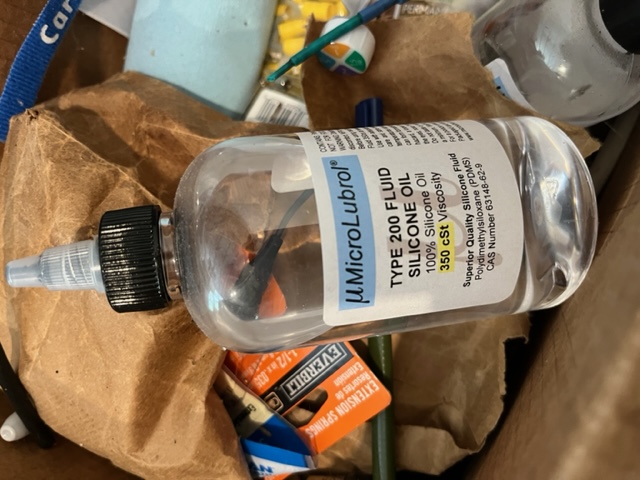
Since this was never intended to be a review of the Oracle Reference 1 tonearm, I won’t go deeply into its features and setup except to say it’s a 4-bearing gimbaled design with precision bearings. Wouldn't want all that bearing precision effort in the 'table to go to waste, right? It was infinitely easier to dial in VTA, azimuth, and VTF than was the Reed 1H or many other high-end tonearms I’ve used. I liked the dial adjustment atop the VTA tower. Anti-skate adjustment is from a pivotal mass with a string connected to the arm head. An internally damped carbon fiber arm tube, attached headshell, a locking cradle piece for the armrest, and end-of-record auto lift round out the package.
At this point, I felt like a Delphi/name-your-tonearm/Lyra Atlas setup expert.
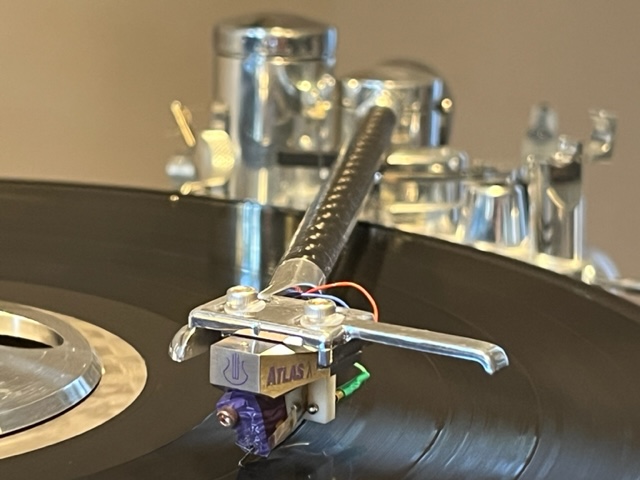
Looking Down From Mount Olympus
And now for the big reveal.
Holy Fresh Baguette, Batman!
The Oracle Delphi Mk VII fitted with the Oracle Reference 1 tonearm (MSRP $5,950 available June 2023) (with a Lyra Atlas Lambda) may be the finest-sounding vinyl playback system I’ve had the pleasure to hear. This rig was among the most rewarding listens ever to grace Chez McAudiophile.
All attributes I hear from the finest vinyl playback gear were in full force with this Oracle Delphi Mk VII/Reference 1/Lyra combo.
My ears got a hefty serving of perfectly balanced, wide bandwidth tonality, with as much detail and dynamic contrasts as I’d ever want. Coupled with the ability to reveal the individual sonic signatures of each record powerfully—and even individual cuts— made records and songs sound unique and more compelling than I’m used to hearing.
Very subtle shadings and musical parts came into focus from all my most played test records. A silky smooth top end with almost total freedom from any tracking-based artifacts. Ultra clean and fast high frequencies with zero grain or edge.
The Oracle setup displayed a sumptuous midrange of primary sonic colors adorned with just the right amount of harmonic filigree. Quiet records were even more silent than I realized.
Inner groove distortion and tracking bummers were almost undetectable and never interfered with pure listening enjoyment. So how could the last track on a 22-minute side sound so clean, I asked myself?
The stereo imaging was otherworldly. I just laughed and shook my head on record after record. The width, depth, layering, and focus seemed more holographic than ever.
Of course, I couldn't resist filling the tonearm-dampening trough with Silicone fluid to play with, even as the sound was excellent without it. I heard the high frequencies become smoother when using the mini hex screw on top of the arm tube to barely break the fluid layer. I could decide how much to burnish the top end, like finish sanding with 600 grit sandpaper. At one point, I had the cone of that tiny little screw in pretty deep with no apparent loss of resolution and detail.
This combo played music at the absolute sweet spot of my imaginary accuracy/listenability matrix.
Accuracy is the wrong word because vinyl is an inherently less accurate storage medium. So even at the farthest reaches of analog gear designed for accuracy, vinyl will sound different from the same design intention when applied to electronics or loudspeakers. And even a basic turntable can play music in a listenable way.
Still, readers of my previous pieces will know that I like a system or a component to be accurate enough to give me a lot of information without tonal aberrations or distortions - but not be so clean as to be musically lifeless and uninvolving. That is the middle of the accuracy/listenability matrix.
The Oracle table/arm combo was a silent basketball swish from half-court, with the net in the middle of my matrix. Dig it, yall.
Once I dialed things in, I could instantly shift into musical enjoyment mode and out of analytical thought. So, naturally, a component that allows me to sink into musical enjoyment quickly gets my highest praise.
Breaking the sound down like this seems wrong because very few of these discrete sensory elements protrude from the magical experience of simply hearing records played on the Delphi/Reference 1 system. But I have to write something, and it’s easy to analyze what I hear, so here we are.
Wrap Up
After going the distance, and boy am I glad I did, I can confidently say that the Oracle Audio Delphi Reference Mk VII turntable, along with the Oracle Reference 1 tonearm, is a proper reference-level combo.
Ordinarily, I wouldn't rave about a prototype, but from what I understand, any minor changes will be in ease of usability with no change to the sonics. I suggest more apparent markings on the VTA tower and a dimple in the exact middle of the arm rotation to make it easier to use a SMARTractor.
The Delphi Mk VII offers many ways of fine-tuning the sound through chassis spring adjustment and silicone damping tweaks. And the latest generation of motor controller boards is also responsible for a fair amount of the sonic excellence I heard. For the genuinely insane, the controller board also has some sonic fine-tuning capability when changing the control voltage. Hell, the arm even has variable dampening to aid in another round of season-to-taste.
Delivered from a dealer fully set up, it's all good if you’re more of a sit-back-and-bathe-in-musical-awesomeness type.
If you are the type to own a Ferrari and like to do your own engine tuneups and suspension fine-tuning, by all means, get down with your turntable optimizing bad self. The capability is there if you want to dive in - or not.
Twenty G’s (before adding the price of a cartridge) is a significant sum - even for some of today’s crazy-priced high-end record playback products.
However, I heard what I heard. And after spending lots of time listening to music played on the Oracle Delphi VII and Reference 1 tonearm, I feel it’s more than a fair price for this level of performance and musical involvement. Some would consider the price-to-performance ratio a bargain!
For those folks like me who consider music and vinyl a major part of life, you do not want to miss hearing this. And it looks gorgeous in a way that pictures don’t do justice to.
Special thanks to Jacques Riendeau, Stephane Nadeau, Valerio Cora, and Isaac Markowitz for helping make it happen.
Highly recommended.
Associated gear:
VAC Master Preamp w phono stage, QLN Prestige Five and Treehaus Audio loudspeakers, Innuos Zen Mini with Forssell Technologies MADA-2a DAC, TW Acustic Raven LS turntable with 10.5 tonearm, Dynavector XV-1t, Benz Ruby Z, and Lyra Atlas Lambda phono carts, Ampsandsound Zion Monos, Bryce Monos, and Red October amplifiers, Cardas Clear Beyond cabling and power strip, Cardas, Analog Magik, and Furutech tonearm cables, Iconoclast by Belden speaker wire and interconnect, Acora Acoustics granite equipment racks, Reliable Uberlight Flex lights, Analog Magik cartridge alignment system, Acoustical Systems SMARTractor overhang jig, Counter Culture - Big Trouble coffee beans, Profitec Pro 500 espresso machine, and So Delicious - Salted Caramel Cluster Cashew Milk Ice Cream.
Specifications
Oracle Delphi Mk VII Reference
$14,000
Dimensions: 363 X 475 X 150 mm ( 14.5 X 19 X 6 inches )
Platter weight: 4kg ( 8,8 pounds )
Sub chassis weight: 3,9kg ( 8,5 pounds )
Total weight: 30,9 kg ( 68 pounds )
Dust cover options: acrylic with hinges or Full ( sold separately )
Oracle Reference 1 Tonearm
$5,950
Center to Center: 223mm
Effective length: 240,3mm
Overhang: 17.3mm
Effective mass: 20 grams
Manufacturer Information
Oracle Audio
6136, Bertrand-Fabi Street
Unit B / Suite 101
Sherbrooke - Québec, Canada
J1N 2P3
Phone : 819) 864-0480




